Food for health

Of all the different diets found in various cultures around the world, the current Western diet of processed foods is the only one that actually makes people sick, so we don't eat a typical Western diet.
The best (and certainly the most succinct) advice we've found about what foods to eat are the seven words on the cover of Michael Pollan's book In Defense of Food: An Eater's Manifesto:
- Eat food.
- Not too much.
- Mostly plants.
Eat food
 ©Janet Allen
©Janet Allen Real oatmeal (not from a package) is a simple, healthy breakfast
What's "food"? Isn't that what everyone eats?
Inspired by Michael Pollan, we regard food as something that our grandparents would recognize, something that doesn't have a label with a long list of unpronounceable chemicals—in other words, real food rather than the "edible, food-like substances" (as Pollan calls them) that fill most of modern grocery stores.
We've always eaten fewer processed foods than most people, but we now eat virtually no processed foods (although we certainly buy prepared food ingredients such as mayonnaise, soy sauce, crackers etc.).
 ©Janet Allen
©Janet Allen We switched to red carrots and had a very successful crop
Over the last few years, we've replaced any processed foods we previously ate by either cooking some simple dishes or by eating just plain food without making a formal recipe. When we go to the store, we buy ingredients, not prepared foods.
Why is this healthier? For one thing, we know what is in our food and what is not. There are no hidden sugars, no preservatives, no artificial flavors. (As the school lunch guru Ann Cooper said, kids need to know—and we adults need to remember—that "grape," for example, is a food, not a flavor…) We know what's in our food because we put it in there!
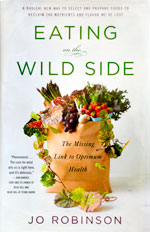
Excellent guide
Another reason is that we use real food as ingredients—often those we grew ourselves in our own good, fertile soil—not "food-stuff" manufactured from corn or soy. No matter what chemical vitamins they add to these fake foods, they aren't the equal of all the micronutrients contained in our real food grown in our own organic garden.
After Michael Pollan's book, the new book Eating on the Wild Side by Jo Robinson has most changed our specific food choices. It has pointed us toward foods that can be actually be found in grocery stores, farmers markets, or grown in our garden that are most closely related to the wild foods that humans evolved with.
Mostly plants
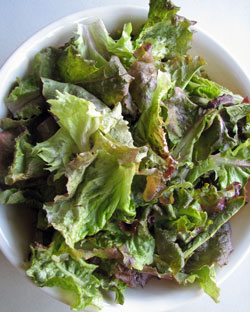 ©Janet Allen
©Janet Allen Some beautiful lettuce from our garden, ready for some delicious additions
Research supports Pollan's recommendation to eat more fruits and vegetables, and to eat less meat.
This may be easier for us to follow than for many people since we're vegetarians, though since we try to have two servings of sardines or canned salmon each week, I suppose were're officially pescetarians.
More specifically, we eat 100% whole grains and lots of vegetables and fruits, and we're trying to increase the amount of vegetables relative to the amount of fruits. For protein, we eat a variety of plant-based options such as beans, seeds, nuts, and occasionally tofu (though not very often). We also eat some dairy, such as yogurt, eggs, and some cheese, in addition to our servings of sardines or canned salmon.
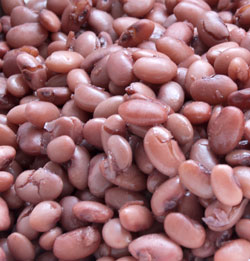 ©Janet Allen
©Janet Allen Beans are full of protein, and the variety of foods during the day combines to make complete protein
Contrary to what most people think, it's not hard to get enough protein, and the average American eats far too much protein anyway. And we don't worry about combining foods to make a complete protein, as was advocated in the Diet for a Small Planet days of long ago. This position has been discredited, and we don't worry about what we eat with what. Besides, with a daily dish of yogurt and the eggs present either as a meal item or in the things we cook, we're getting plenty of protein anyway.
And note that the USDA's ChooseMyPlate.gov considers one-fourth cup of cooked beans or peas to be a 1 ounce equivalent in the Protein Foods Group.
Ironically, many people who worry whether we're possibly getting enough protein are the same people who are getting a woefully small amount of what nutritionists agree are the most important things to eat: vegetables and fruits.
Not too much
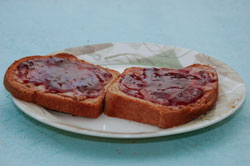 ©Janet Allen
©Janet Allen We use the smallest plate that fits
It's always a challenge to eat "not too much"—especially with the delicious food we have! To help moderate our portions, we follow Brian Wansink's advice on "Mindless Eating" based on his large body of research conducted at Cornell.
Among other things he suggests, we've stored away our dinner plates and use what are considered to be luncheon plates for our main plates. For food we want to have in modest proportions, we use the small dessert dishes rather than the soup bowls, and so on.
It's just a question of stacking the deck in our favor!
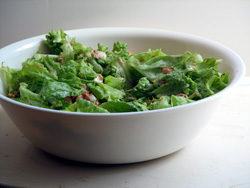 ©Janet Allen
©Janet Allen We use a giant bowl for healthy food
On the other hand, when we want to maximize what we're eating—for example, a beautiful salad full of all sorts of vegetables—instead of the usual cereal or salad bowl sizes, we use what are generally considered to be serving bowls. Sprinkled with some grated cheese, bits of hard-boiled eggs, or other condiments, we have a beautiful big meal. We do this every day during gardening season.
Another benefit
 ©Janet Allen
©Janet Allen Cooking even in the old days
A healthful diet is part of the recipe for good health, but we get a second benefit, too.
When we grow our food and cook it, we're getting the kind of everyday activities our bodies were designed for.
As more and more research shows, the average American's sedentary lifestyle is extremely unhealthy. What better way to incorporate movement into daily life than harvesting and creating delicious food!
Even when traveling
 ©Janet Allen
©Janet Allen Lunch on the road, eating grocery store stuff at a rest stop
We've created our favorite quick lunch on the road, which avoids stopping at fast food places. We simply go to any grocery store and buy hummos and Triscuits, a bag of baby carrots, and a bag of dried fruit.
Actually the baby carrots aren't ordinarily the best choice since they're just regular carrots with all the most nutritious parts ground out, but since they require no preparation, they're convenient for a a road trip. And if we are able to plan ahead, we just prepare real carrot sticks in the morning and take them with us, though that's not always possible when traveling.
This meal is inexpensive, it's easy to eat without a lot of tableware, and it's nutritious. It's pretty much just food (the Triscuits and hummos don't have too many ingredients), all plants, and not too much. It doesn't take much time either, and enables us to stop at an attractive rest area to eat rather than eating in one of those fast food places.
It does create a modest amount of waste, but not excessive considering the alternatives.
We really enjoy this simple meal! It has become a traveling tradition we look forward to, especially since Triscuits are one of those foods I can't resist, so I never buy them otherwise.
